
Humboldt County’s Marijuana Boom Is Destroying Redwoods and Killing Rare Wildlife
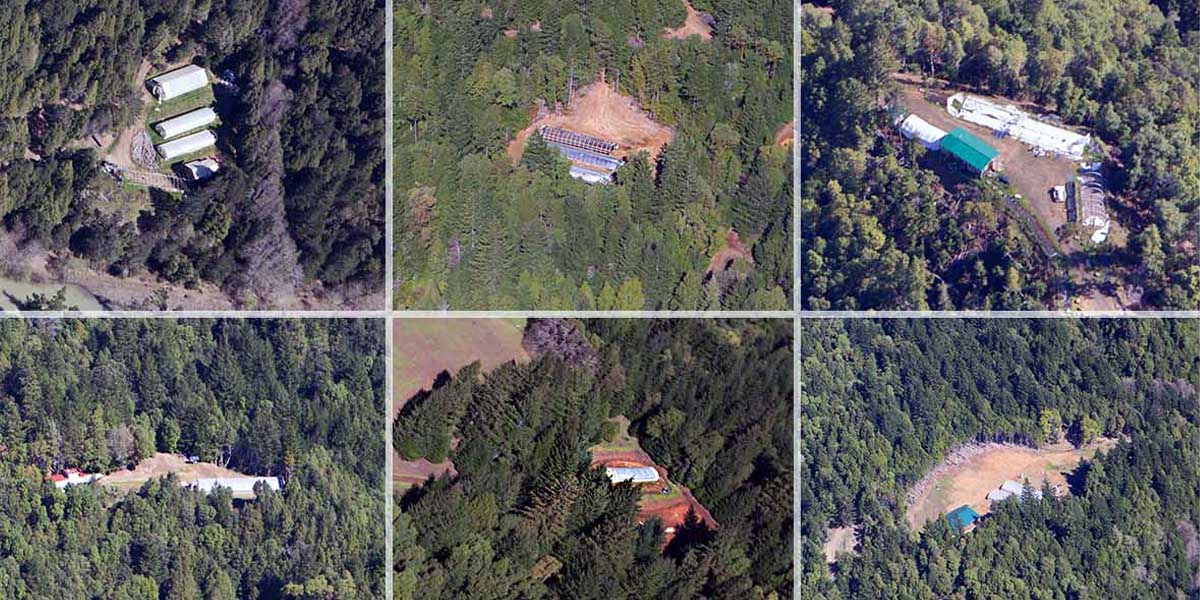
By Todd Woody
Mark Harris banks the Cessna 182 over the blue expanse of Humboldt Bay and flies toward the redwood-studded hills beyond, to the now-quiet battlefields of the California timber wars. It’s a flashback moment. Twenty-one years ago, Harris, then a ponytailed young attorney, took me, then a long-haired young reporter, up in Thumper, as he affectionately calls the 59-year-old prop plane, for an aerial view of the civil war raging in Humboldt County.
In the forests below, activists from the radical environmental group Earth First!—”No compromise in defense of Mother Earth”—were fighting a long and brutal battle to save the planet’s largest groves of ancient redwood trees left in private ownership from a timber company determined to cut down every last one of them. Harris represented these “forest defenders”—who blockaded logging roads and chained themselves to chain saws—as well as their compatriots, who battled in the courts to stop the clear-cutting of trees that sprouted when Julius Caesar ruled the Roman Empire.
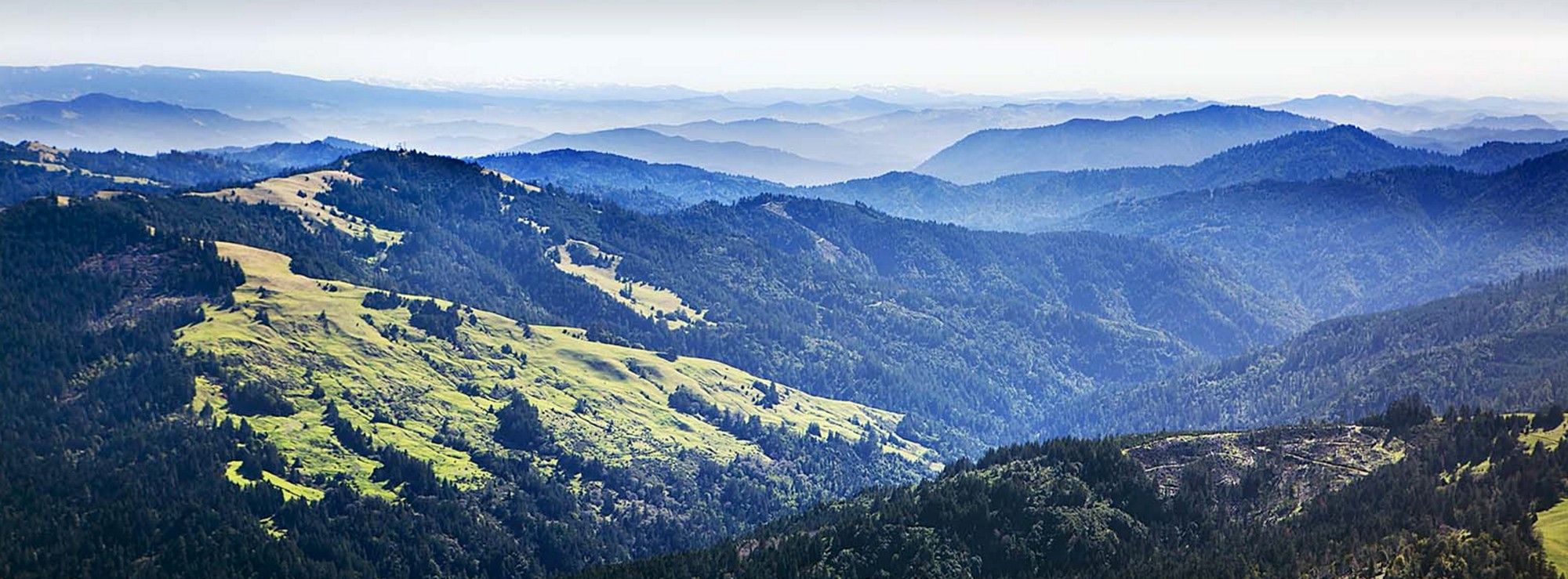
On this bright and sunny March day in 2016, I can see the victories and defeats etched in the landscape framed by the snowcapped Trinity Alps. Vast tracts of stump-covered hillsides abut soaring stands of redwoods.
“Look, there’s Owl Creek,” said Harris over the din of the four-seater’s engine. In 1995, he helped win a landmark court victory that blocked the Pacific Lumber Company from logging the grove of old-growth redwoods that is home to a rare and rarely seen seabird called the marbled murrelet. Then on our right appears the Headwaters Grove. From a thousand feet up, the 3,000 acres of densely packed, 2,000-year-old, 300-feet-tall trees appear as an island amid the clear-cuts, looking like nothing so much as gargantuan marijuana buds.
The Headwaters, which harbors northern spotted owls, Pacific fishers, Humboldt martens, coho salmon and other endangered wildlife, is Humboldt County’s Gettysburg, a battleground where thousands of activists risked arrest, pepper spray and the wrath of angry loggers to protect a primeval world from Charles Hurwitz, a Texas corporate raider whose Maxxam Corporation took over Pacific Lumber in 1986 and began clear-cutting the ancient trees, each one worth as much as $150,000. In 1999, the federal and state governments paid Hurwitz $480 million to acquire the grove and the surrounding Headwaters Forest. Pacific Lumber went bankrupt eight years later, its assets scooped up by the Humboldt Redwood Company, which pledged to log sustainably and not harvest old-growth trees. The timber wars were, at long last, over.
Another fight for the forests, though, is just beginning.
We shadow the Eel River, swollen from El Niño rains, as it meanders past the county’s last sawmill and then head into SoHum, as locals call southern Humboldt. Flying toward the Pacific Ocean, we pass over redwood-covered hills pockmarked by dozens of clearings hacked from the forest. This land is zoned for timber production, but loggers didn’t cut down those trees. In just about every clearing, long white cylinder-shaped structures appear, resembling, some say, rolling papers. It’s an apt observation. The buildings are greenhouses and inside, marijuana plants are grown for Humboldt County’s multibillion-dollar cannabis industry.
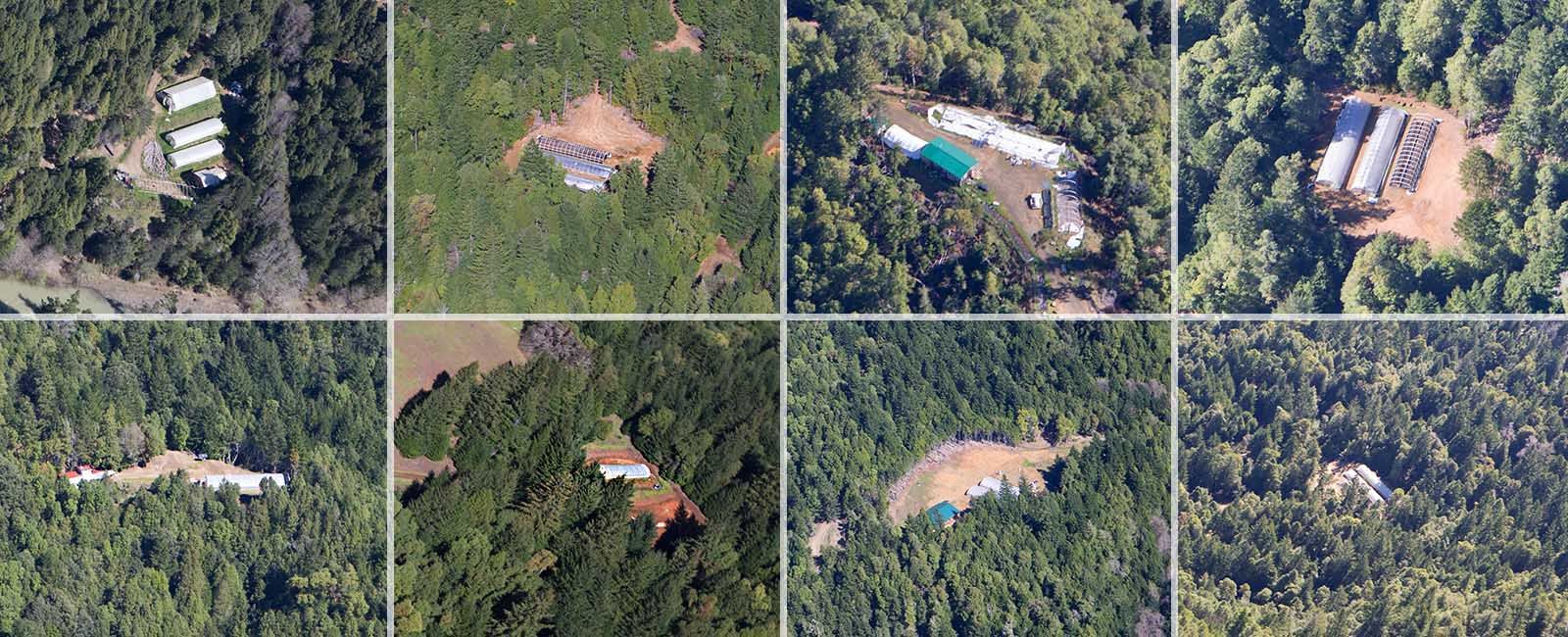
With California poised to fully legalize marijuana, a “green rush” has hit Humboldt as outsiders—Bulgarians, Laotians, Texans—flood into the county and set up industrial-scale marijuana farms. The environmental impact from more than 4,000 pot “gardens” is ravaging the redwood ecosystem that Humboldt environmentalists have spent decades fighting to save and restore. And not just in Humboldt. The marijuana boom in the two other pot-growing counties that form California’s Emerald Triangle threatens a wide swath of the state’s woodlands. Like forests worldwide endangered by development, Humboldt County’s redwoods absorb huge amounts of carbon dioxide, making them crucial to the fight against climate change.
Full Coverage: Fight for the Forests
“The single biggest threat to our environment right now has been unregulated cannabis,” said Natalynne DeLapp, executive director of the Environmental Protection Information Center, a grassroots group that spearheaded the effort to protect the Headwaters and its wildlife. “In the last 20 years we’ve seen a massive exponential growth in cannabis production in the hills of Humboldt County and we’ve seen really devastating environmental effects.”
Growers have fragmented forests by cutting trees to build greenhouses and roads on steep hillsides, choking creeks home to endangered salmon with sediment, fertilizers and pesticides and sucking streams dry during a record drought to irrigate marijuana crops. Once-still forests echo with the racket of hundreds of diesel generators. Rat poison and other toxic chemicals used by some growers to protect their plants are killing rare wildlife like the Pacific fisher.
“It’s just been really sad, actually, really sad to see what’s happened to the environment and a lot of work people have put into restoration efforts, to see those things unravel because people continue to bulldoze hillsides for clearings to grow more cannabis,” DeLapp said.
In a community where there long has been a very thin green line between environmentalists and marijuana growers, DeLapp, 35, is leading a campaign to regulate an out-of-control industry. She’s getting help from unlikely allies: a timber company and a group of marijuana farmers determined to create a truly green and sustainable cash crop.
Hiding in the Hills
Pot has been grown in these hills since the back-to-the-land movement of the late 1960s and early ’70s brought hippies to Humboldt, a sparsely populated 4,052-square-mile rural county in Northern California. That a remote region known as the Lost Coast would become a haven for marijuana growers was no accident. “Humboldt County may not be the best place to grow marijuana from an environmental standpoint, but it’s the best place to hide growing cannabis,” noted DeLapp.
For decades, it was mostly grown by locals like Stephen Dillon, who comes from a fourth-generation Humboldt logging family that arrived in the county by schooner in the 1880s. His grandfather worked in the mills until he died, but when the timber wars erupted, Dillon sided with Earth First! after a foray into the Headwaters Grove in 1991. It was the year after “Redwood Summer,” the first of a decade of mass protests against logging that would bring thousands of demonstrators and celebrities such as Bonnie Raitt and Woody Harrelson to Humboldt County.
“We could barely penetrate it,” Dillon said of the Headwaters. “All we could do is find an old growth tree, walk along it, jump down into 20 feet of ferns, find another one, walk along it. There’s nothing like it in the world. Jurassic Park is the closest you can describe.” Dodging Pacific Lumber security guards, Dillon and his buddies found a way out of the forest. “We walked to the edge of Headwaters, then tried to get across a clear-cut. It was just like death and destruction outside the grove.”
Still in college, with a new baby, he began to grow marijuana while attending Earth First! rallies. “We were taught by the old hippies to grow under the shade of the trees,” said Dillon, a sandy-haired 43-year-old sporting a goatee. “It really dovetailed with the Earth First! activist scene—they’re both really antiestablishment; they’re both in direct contact with nature in the woods, being free and working.”
“Back then, it was the old hippies and the Vietnam vets who pretty much controlled the whole marijuana scene,” he said. “They supported the volunteer fire departments, built the community centers.” At environmental groups like EPIC, veteran activists tell stories, perhaps apocryphal, of bags of cash and weed appearing on office doorsteps to fund their good works.
“This was back in the day when weed was very expensive—$4,000 a pound,” said Dillon. “A family could get by on 20, 30, 40 pounds a year and be happy.” Today, prices have dropped below $2,000 a pound and as farmers grow more marijuana to make up the shortfall, the environmental impact grows too.
Mom-and-pop backyard pot gardens got bigger after 1996 when California voters passed Proposition 215, which legalized marijuana for medical use. After spending decades trying to eradicate marijuana in Humboldt County, the state started treating the business as quasi-legal, at least if growers were supplying the medical marijuana market. People like Dillon came out of the woods and started growing pot in greenhouses. “I was the first greenhouse in my valley since the ’80s,” he said. “Now I’d say there are over 200. Mine are the smaller ones.”
“New people came and got money signs in their eyes,” added Dillon, executive director of the Humboldt Sun Growers Guild, a cooperative of local farmers who promote organic, sustainably grown marijuana. “They were like, ‘Screw that hippie down the road—he’s a wuss. Let’s throw up five of these things in a row.’ A lot of the new people coming in have absolutely no understanding of the creeks and the roads and the ecosystem they’re in.”
Video: Up in Smoke: Humboldt County’s Green Rush
Ironically, the decline of the timber industry helped spur the rise of an environmentally destructive marijuana industry. As the sawmills closed, out-of-work loggers began growing pot, while Humboldt’s old logging families began to sell off their timberlands to outsiders who would subdivide the property and sell to other marijuana growers. “The old-timers are up against a rock and a hard place as they’ve got taxes to pay on their land but it’s not economically feasible for them to log it anymore,” Dillon said. “So they sell and the only person sitting on the other side of the table is a pot grower with a lot of cash.”
I’m talking to Dillon not on his farm but at the “Marijuana Investor Summit” in San Francisco. The March event at the Hilton San Francisco Union Square has attracted 1,300 attendees paying $750 a pop and Dillon has come to see what the future holds. The hotel reeks of weed, but the conversations of the suits sitting around us are about money and market share.
“These guys are literally stockbrokers and hedge fund people, trying to figure out how to get into the business,” said Dillon, uncharacteristically attired in a sports jacket and a button-down shirt, glancing over his shoulder. “They have no regard for the environment, the culture, the land, the communities involved. They have absolutely no stake in any of those things. It’s all about the money.”
By any measure, enormous sums of money are flowing through Humboldt County, such as the $500,000 police officers found stashed in a false compartment in a 61-year-old Humboldt man’s pickup truck during a routine traffic stop in Utah.
“He obviously had just transported marijuana from Humboldt to that state and was on his way back—the scent of marijuana was very strong,” said Humboldt County Sheriff Mike Downey, noting that his office typically seizes $1 million to $2 million in cash a year from growers. When Humboldt sheriff’s deputies subsequently raided the man’s home in a remote corner of the county, they found 1,200 pot plants growing in five greenhouses, along with 230 pounds of dried marijuana.
Few signs remain of the timber industry, which in the 1950s employed half the Humboldt County workforce. Signs of the cannabis culture, though, are everywhere, from the highway billboard advertising a sale on gigantic inflatable water tanks favored by growers for irrigating their crops to the plaque in my hotel room advising, “For your comfort this is designated a non-smoking/non-medical Prop 215/non-pet friendly room.” Conversations inevitably turn to drug-related topics. The next-door neighbor busted in Missouri for transporting marijuana. The young eastern European women arrested working at a grow operation. The barrel-chested, tattooed Bulgarian guy spotted in the hills carrying an AK-47 and talking on a satellite phone.
“The Bulgarian grows are horrendous!” wrote a commenter on Redheaded Blackbelt, a local news blog that reports on all things cannabis. “You said the ‘B’ word,” another commenter replied. “They are taking over this county, buying land all over. Seems like every time I go to the mountain store the guy in front of me is wearing a track suit and speaking Eastern European.”
Signs of the environmental devastation wrought by renegade cannabis cultivation, though, are largely out of sight. When I contact a local environmentalist to see if he can show me the damage, I get a curt reply: “You are aware that these are not friendly hills to drive around in, right?” Residents of those hills who have witnessed firsthand the destruction of streams and forests aren’t eager to talk to the media, he said, mentioning a friend who is “afraid of winding up in a ditch, leaving his kids without a dad.”
I’ll hear the phrase “Snitches get stitches” more than once while I’m in Humboldt.
Growing Devastation
Heeding the warning, I decide the safe bet is to report from 1,000 feet up aboard Thumper with a guide familiar with the terrain. Since the timber wars, Mark Harris, a surfer turned attorney and now a youthful 54, has developed a thriving legal practice representing local marijuana farmers and groups like the Humboldt Sun Growers Guild.
As we fly toward SoHum’s marijuana belt, we pass the last paved road we’ll see, deserted but for a flatbed truck stacked with soil and fertilizer. “During growing season you’ll see those trucks running back and forth all day long,” said Harris, throttling back the engine to slow the plane as the photographer with me pushes open a window, sticks her head out and starts shooting the greenhouses sitting on patches of dirt carved from the redwood forest. “I’m surprised no one down there has called me yet saying, ‘Hey Mark, is that you up there?’ ” he said, chuckling and glancing at his iPhone. Often, he said, the sight of a low-flying plane triggers alarm below as growers spread the word through the hills of a possible incursion by law enforcement. To avoid freaking growers out, Harris often posts a notice on the Redheaded Blackbelt blog that he’ll be doing a flyover.
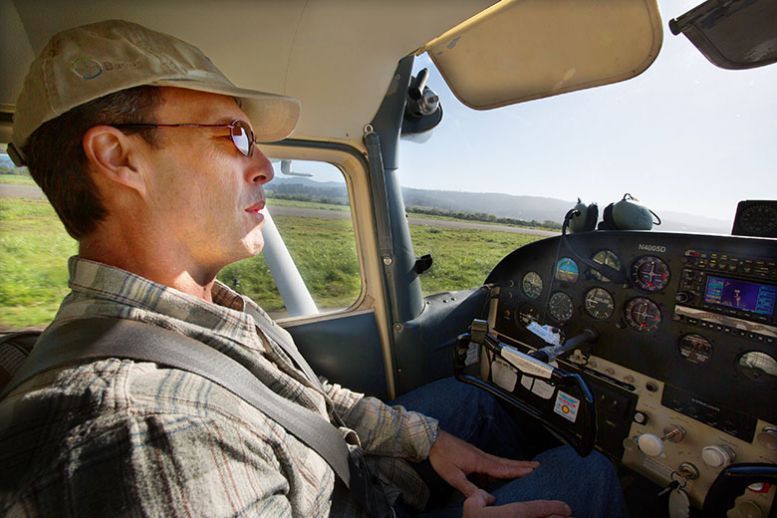
Visible through the trees is a network of narrow dirt roads that snake through the redwoods to greenhouses. Some are old logging roads from the 1940s that growers have reopened; others they built themselves. Either way, the poor construction means that come the winter rains they erode, washing sediment into streams where endangered coho and chinook salmon spawn. Something catches Harris’ eye and he swings over three greenhouses sitting on clearings that had been hacked from a hillside above a muddy creek. Redwoods have been cut down for two other grow sites just yards from the water. “In some watersheds you see a 100, 200 of these,” said Scott Bauer, an environmental scientist with the California Department of Fish and Wildlife who went on 40 raids of marijuana grow operations last year. “So you see forest fragmentation; you see road building that’s atrocious.”
In places like the nearby Salmon Creek, he said, the state has spent millions of dollars decommissioning old timber roads while residents have worked to restore watersheds left damaged and devoid of salmon by decades of industrial logging. Then came the green rush. “There’s hundreds of grow sites in there,” said Bauer. “You go out there today and the creek runs chocolate. It’s just puking sediment and you used to didn’t see that. I saw chinook spawning there in 2009 and I’ve been back a number of times and it’s just running like mud. Even if the salmon are spawning, you can imagine that survival isn’t that great.”
We fly over another clearing in the forest that is being prepared for the upcoming growing season. The metal frame of a greenhouse sits next to an empty inflatable water storage tank the size of a suburban swimming pool. Supersize versions of the water bladders you take camping, the tanks can hold 5,000 gallons and weigh 42,000 pounds when full. “If the grow site hasn’t been properly graded, the tanks can get loose,” said Harris. “They go crashing down the hill taking out trees until they hit the creek.”
That some pot farmers are using such tanks to store water collected in the rainy season is a positive sign, given the devastation caused by the pumping of streams and creeks during the dry summer months to irrigate thirsty marijuana plants. A 2015 study coauthored by Bauer found that in the summer, growers were diverting as much as 100 percent of the water from some Humboldt County streams, including Salmon Creek.
That is jeopardizing the survival of salmon across the region, according to Scott Greacen, executive director of Friends of the Eel River, an environmental group involved in the recovery of Humboldt County’s watersheds. Take China Creek, a coho spawning stream that’s a tributary of bigger creeks that flow to the ocean. “Ten years ago we had coho in China Creek,” said Greacen, a ponytailed 51-year-old who formerly served as executive director of EPIC. “Now we have lost them completely because someone built a dam at the top of the creek and cut off the flow of water. When the wardens showed up, all they found was dead fish.”
More commonly, he notes, a group of growers will fire up their diesel generators at the same time and pump dry a pool where salmon are swimming. The water will percolate back into the creek when they turn off their pumps, but the pool only has to be dry for a minute for the fish to die. “It’s a death by a thousand cuts,” said Greacen. “In the timber-wars era, we could take you to these massive clear-cuts and the impact on the forest was obvious for anyone to see. Now it’s not the greenhouse itself or the pot plants themselves that are the harm, but it’s the land use associated with it and the cumulative impact of hundreds of these grow sites.”
What we can’t see from the air are the animals dying in the forests from rat poison and other toxic chemicals some growers use to protect their plants. The threat has become so dire that when the federal government proposed listing the Pacific fisher as a threatened species, it cited cannabis cultivation as a risk to the mammal’s survival.
Death by Cannabis
Seven years ago, wildlife ecologist Mourad Gabriel was a doctoral student at the University of California, Davis, where he tracked the behavior of a group of radio-collared fishers, elusive cat-size carnivores that resemble wolverines, only cuter. Fishers, whose numbers have fallen as low as 500 in Northern California, prefer the same mix of old-growth forest and riparian habitat favored by the northern spotted owl—and, increasingly, outlaw marijuana growers.
After a radio-collared fisher was found dead in a remote forest in 2009, an autopsy revealed it had died from poisoning by a rodenticide commonly used on illegal grow sites to kill rats and other animals that like to eat sugar-laden young pot plants and that fishers prey on in turn. As the green rush brought more of these “trespass grows” into state and national forests and parks and onto private timberlands, the fisher death toll rose. In a 2012 study, Gabriel and his colleagues found that 79 percent of 58 fishers they examined had been exposed to rodenticides, four had died and a nursing female had passed the poison on to her offspring. By late last year, the death rate from poisoning hit 18 percent of the radio-collared population.

Gabriel began to accompany law enforcement officers on raids of grow sites, finding anywhere from five to 120 pounds of rodenticides—some banned in the U.S.—spread around every one. “You can feel the death in the air,” he told me as we walked along the Mad River, which borders a forest that is prime Humboldt County fisher habitat. There’s also a marijuana grow site nearby. “They were intentionally and maliciously poisoning wildlife, putting out rodenticides in tuna cans. As little as an eighth or a sixteenth of a teaspoon of some of these poisons can kill an American black bear. Three ounces of another will kill one-and-a-half spotted owls.”
Last year, two endangered northern spotted owls found near grow sites had rodenticides in their system, as did 80 percent of barred owls that had been culled to stop them from competing with their endangered cousin. The federal government in the 1990s put much of the Pacific Northwest off-limits to logging and has spent millions of dollars to save the spotted owl. Gabriel also came across dead bears, foxes, birds and vultures near marijuana grow sites last year. Each tested positive for rodenticides and other poisons. Also at risk is the Humboldt marten, a weasel-like carnivore that lives in old-growth redwood forests and that was thought extinct until a camera trap captured a photo of one in 1996. The marten and the spotted owl hunt the same prey as fishers.
“Think of all the folks who were galvanized to protect the Headwaters and the unique ecosystem that supports this wildlife,” said Gabriel, who is executive director of the nonprofit Integral Ecology Research Center in Blue Lake, a hamlet of 1,200 people east of Eureka. “It doesn’t matter how good-quality the habitat is if you have these new threats from marijuana grow sites.”
At one site, growers had strung a line of fishing hooks baited with hot dogs laced with methomyl, an extremely toxic pesticide. Gabriel discovered a dead two-year-old male fisher 30 feet from the camp, poisoned meat lodged in its esophagus. The pesticide had killed the fisher before it could swallow the hot dog. “I’m disheartened. It’s heartbreaking,” says Gabriel, who had just returned from conducting an autopsy on yet another fisher. Cause of death: rodenticide.
It has also gotten personal. Some marijuana growers apparently were not happy when Gabriel’s 2012 study attracted widespread media attention. People threatened Gabriel at the supermarket and the gas station, he said. His office was broken into. He woke one morning to find one of his Labradors writhing in agony. An autopsy would show that the dog had been poisoned with the same rodenticide Gabriel had linked to fisher deaths. “The harassment has dissipated, but it still goes on,” he said. “I let law enforcement handle it.”
Headwaters Forest Reserve
Old-growth redwood trees in the Headwaters Forest Reserve in Humboldt County, California, can reach heights of 300 feet or more. Photo credit: Mary Grace McKernan
Humboldt County’s Last Sawmill
The decline of the timber industry in Humboldt Country, California, has left only one operating mill, owned by the Humboldt Redwood Company. Photo credit: Mary Grace McKernan
Still Standing
This 1,000-year-old redwood tree in the Headwaters Forest Reserve in Humboldt County, California, bears a slash of blue paint that once marked it for the sawmill. Photo credit: Mary Grace McKernan
Growing Strong
Ancient Redwood trees like these in the Headwaters Forest Reserve in Humboldt County, California, continue growing and absorbing carbon dioxide even after 1,000 years. Photo credit: Mary Grace McKernan
Cash Crop
Greenhouses in Humboldt County, California, where marijuana is grown, sit on a clearing carved from a grove of trees. Photo credit: Mary Grace McKernan
Sitting on a Fallen Giant
Local Kristi Wrigley (left) and Julie Clark, a Headwaters Forest Reserve park ranger, perch on a redwood tree that has fallen across the trail in the Headwaters. Photo credit: Mary Grace McKernan
Growing Marijuana Responsibly
A marijuana farm uses a storage pond to irrigate plants rather than draw water from depleted creeks that are home to endangered salmon. Photo credit: Mary Grace McKernan
The environmental threat from cannabis cultivation hit too close to home last year. A hunter, Gabriel shot a quail in Humboldt County and prepared the bird for his family for dinner. After the bird was eaten, a thought struck him. “I saved some meat and said to myself that if we’re getting material from the same areas as grow sites, I should have it tested.” The lab results showed that the meat was contaminated with a highly lethal rodenticide, the same poison Gabriel routinely found at marijuana grow sites. How the bird became contaminated is unknown, but to Gabriel it’s a worrying sign that such poisons are spreading through the food chain.
“What does that mean for the local indigenous people who are almost 100 percent dependent on hunting for game species like deer and salmon?” he asked, referring to the nearby Hoopa community. “I would have never thought that if I hunted a wild animal out in a remote forest that I would have to have it tested for toxicants.”
Gabriel estimates that only a fraction of trespass grow sites are detected. “There may be 10,000 to 20,000 sites that still need to be cleaned up,” he said. “With the 300 to 500 grow sites law enforcement eradicates each year, you could just see the numbers just piling and piling up. What we worry about is that wildlife and their habitat are slowly drowning in these toxicants that will be in the environment for decades to come.”
The Sustainable Solution
Mention rodenticides and Stephen Dillon just shakes his head. “I’ve never bought rat poison over 26 years of growing,” he said. “We would set rat traps and tie them to trees and the foxes and bobcats would come by every night and clean the traps for us.”
In 2014, Dillon and other local longtime marijuana farmers formed the Humboldt Sun Growers Guild as fears grew that the outsiders setting up industrial marijuana operations were destroying the environment and undermining the Humboldt cannabis economy, much as the unsustainable logging of the 1990s doomed the timber industry. The idea: If local growers banded together, they could use their collective market power to create a brand, True Humboldt, that would sell only organic, sustainably raised marijuana. In other words, the Whole Foods of pot. “True Humboldt cannabis is raised the good, old-fashioned way: under the California sun … We believe in sustainability, organic cultivation techniques and conservation of water,” reads a brochure from the group.
The Humboldt Sun Growers Guild growers then did something unthinkable for people who spent decades dodging government helicopters sent to eradicate their crops and throw them in jail: They asked the county to regulate their industry, setting standards for land, water, pesticide and energy use as well as banning the conversion of timber lands for marijuana farms.
“We’re trying to prevent another extractive industry from rising and prevent another boom/bust cycle like fishing and logging,” said Harris, the group’s attorney. “Humboldt County cannot endure another couple of years of drought conditions with the level of resource extraction going on with these industrial-scale marijuana grows. It’s horrible.”
Humboldt County’s back-to-the-landers helped form EPIC in 1977 in part to fight the government’s spraying of marijuana crops with highly toxic herbicides. Now the environmental group has joined the fight to force marijuana farmers to stop using poisons and comply with environmental regulations. In October 2015, nearly 20 years after the legalization of medical marijuana, California Gov. Jerry Brown signed into law legislation that authorized counties to regulate marijuana cultivation. Humboldt County’s board of supervisors in January approved the state’s first ordinance to license marijuana farming, giving growers until the end of the year to register and obtain permits that govern their use of water, energy and rodenticides.
“Cannabis has been a completely unregulated industry in California,” said DeLapp, EPIC’s executive director. “If farmers agree to store water and other best practices, they don’t have to hide in the woods and we can get them out of the deepest areas that impact wildlife.”
She found a seemingly surprising ally in the Humboldt Redwood Company when timber executives company joined forces with their erstwhile antagonists to push for protections of timberlands from growers. In 2012, company security officers stumbled across a campsite and found more than 5,500 marijuana plants growing on Humboldt Redwood timberland. Last July, sheriff’s deputies cut down 270 pot plants, some as tall as seven feet, on company property. Job requirements for Humboldt Redwood security officers include “planning of eradication activities and prosecution of people cultivating marijuana on company property,” according to an advertisement.
Compliance with the ordinance will take cash. A lot of it. Outlaw growers are unlikely to seek permits and spend the money to repair roads, build water storage and take other environmental precautions, promoters of the ordinance acknowledge. Still, said Dillon, regulation of cannabis cultivation could free up law enforcement to focus on the worst offenders. “I’m not a big advocate of the government after spending my whole life in the pot wars, but there are people who are destroying the environment that need to be held accountable,” he said. “For True Humboldt it’s about protecting the small and mid-range farmer and creating a viable industry that’s going to pass all the environmental scrutiny it needs to. We welcome environmental regulation.”
During the flyover, Harris points out greenhouses built on land that has been properly graded and supplied by ponds that store water collected during the winter rains so depleted creeks aren’t tapped in the hot, dry summers. “People are trying to do the right thing,” he said. “We need to make that the norm.”
Restoring the Redwoods
The high stakes for the redwood ecosystem are driven home when I visit the 7,500-acre Headwaters Forest Reserve, which includes the Headwaters Grove and which was nearly lost to another unsustainable industry. Park ranger Julie Clark and David LaFever, Headwaters’ forest ecologist, lead me down the Salmon Creek trail through a fern-covered woodland of redwood, Douglas fir, and red alder. Seventeen years ago, when Pacific Lumber turned over Headwaters to the U.S. Bureau of Land Management, Clark recalls, this was a wasteland, the old-growth redwoods leveled to make room for logging roads. BLM hired a Pacific Lumber worker who helped build those roads to remove them, taking out 100,000 dump trucks’ worth of sediment. The trees aren’t the only thing that has returned. “A mountain lion’s been here,” said LaFever, bending down to examine an unmistakable paw print and scat peppered with the white bones of some creature. Farther up the trail, Clark points to a tree etched with long claw marks. “That’s from a black bear.” Sometimes she’ll find an anchovy on the forest floor, dropped by a marbled murrelet as the seabird returns from the ocean with dinner for its chick nesting high on a mossy branch of an old-growth redwood.
As the trail starts to climb, the air cools and we enter a grove of redwoods soaring to heights of 300 feet amid newly flowering trillium, a delicate white plant with yellow stamens that blossoms but a few weeks a year in the shade of the 1,000-year-old trees. Nearly all the redwoods bear a slash of bright-blue paint that once marked them for the sawmill. “Either Pacific Lumber didn’t make it this far or the company got tied up in litigation, but for whatever reason these trees survived until the Headwaters deal,” said LaFever, standing next to what Clark calls the “family tree,” a giant amid giants with three trunks sprouting from one root system.
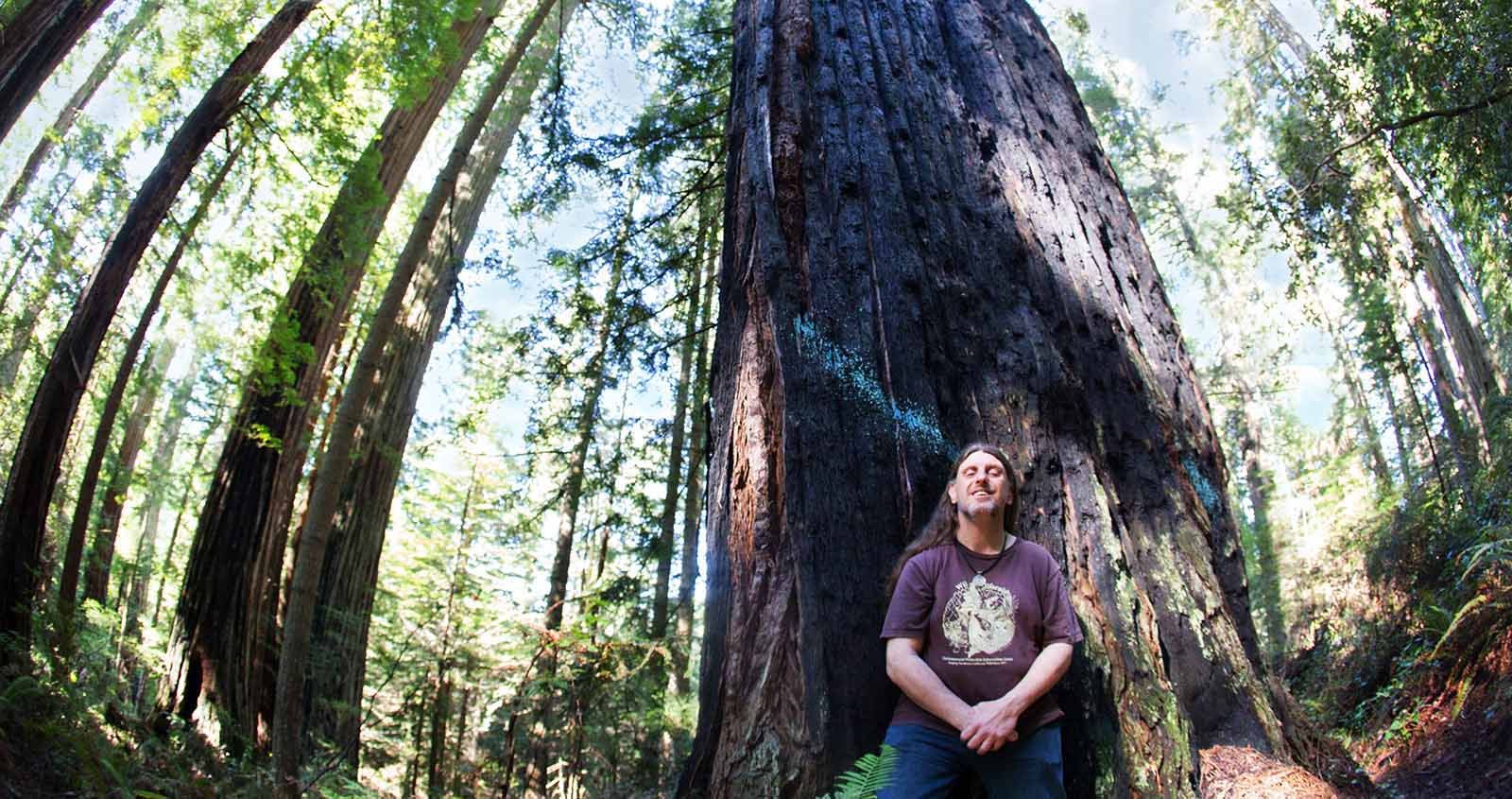
With us is Rob DiPerna, EPIC’s forest and wildlife advocate. In the late ’90s, DiPerna was an Earth First! activist, infiltrating these forests and lugging sacks of concrete to build barricades on logging roads and sitting in old-growth redwoods to prevent loggers from cutting them down. “We were trying to do anything we could to keep the trees standing,” said DiPerna, 45, whose nearly waist-length hair shows a hint of gray. “To be in the forest under the cover of darkness, trying to avoid loggers, cops and security—it affects the individual more profoundly than people realize.”
“The sobering part of it for me standing here is to realize that there isn’t much old-growth redwood left, and the fact that these trees are still here is an actual miracle,” he said as he strains to see the top of the family tree.
When we reach a ridgeline, we can see the core Headwaters Grove across a clear-cut valley that is regenerating. The grove is off-limits to the public to protect its unique ecosystem and wildlife. Along a path to the Headwaters visitor center is a grove of 50 redwood seedlings planted last year and “dedicated to the visionaries and activists who dedicated countless days, months, and years to protect the Headwaters Forest Reserve,” according to a plaque. It feels a bit like a memorial to a long-ago struggle, but to DiPerna and other activists, the fight goes on. The government only acquired 7,500 acres of the 60,000 that activists wanted protected, and DiPerna continues to work to limit the impact of ongoing logging and restore a damaged ecosystem. Nor are the timber wars over for people like Kristi Wrigley, whose family settled on the Elk River in the 1880s outside what is now the Headwaters Forest Reserve. After Pacific Lumber’s timber harvesting increased 10-fold in the 1980s, the Elk River began to regularly flood her property as a result of the dirt washed into the stream from the hills where logging continues to this day. “I no longer can farm my apple farm that’s been in my family for generations,” Wrigley said as we stand on the banks of the south fork of the Elk River, the water muddy with sediment. “We’ve already had five floods this year and it’s only March.”
For Scott Greacen, the environmental activist, the green rush is so dangerous because it threatens to push to the point of no return forests devastated by industrial logging. There is, he said, a far more critical use of redwood forests in an era of accelerating climate change: “My deepest hope for the redwood region is that we come to our senses as a society quick enough to say that the highest and best use for this landscape is putting carbon back in the bowels of these big fat organisms that are incredibly good at accumulating it.”
This article was reposted with permission from our media associate TakePart.

 233k
233k  41k
41k  Subscribe
Subscribe 















